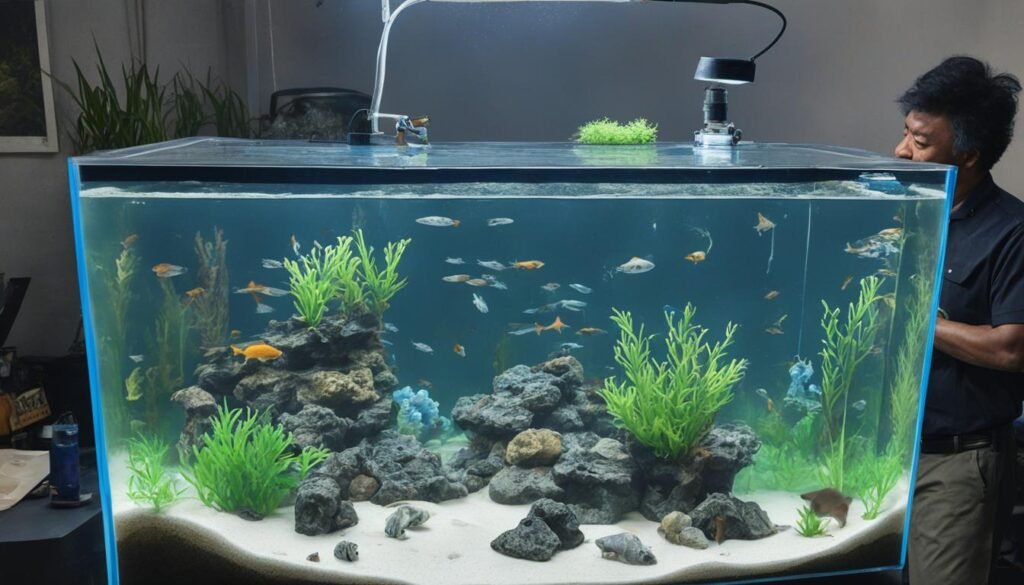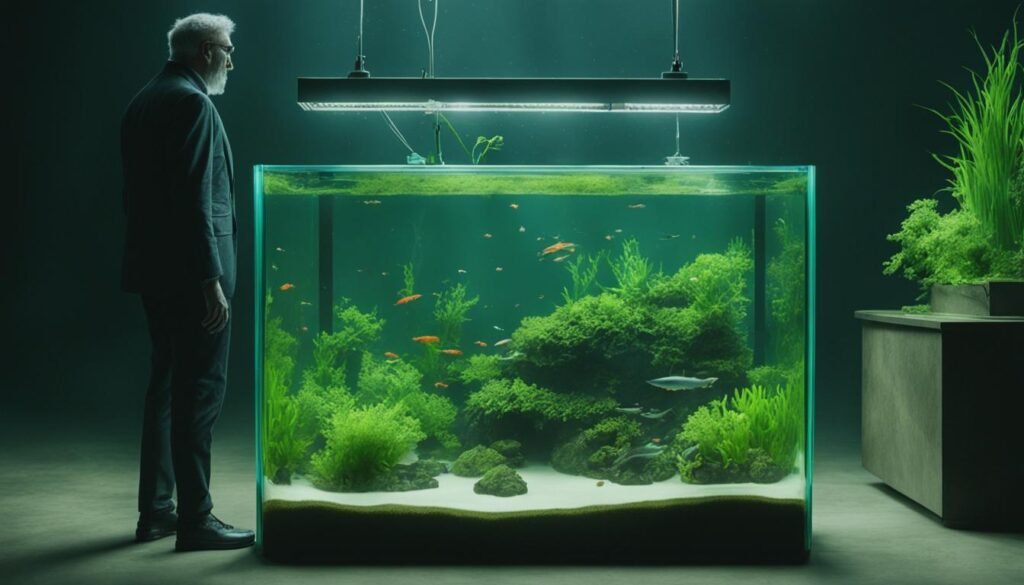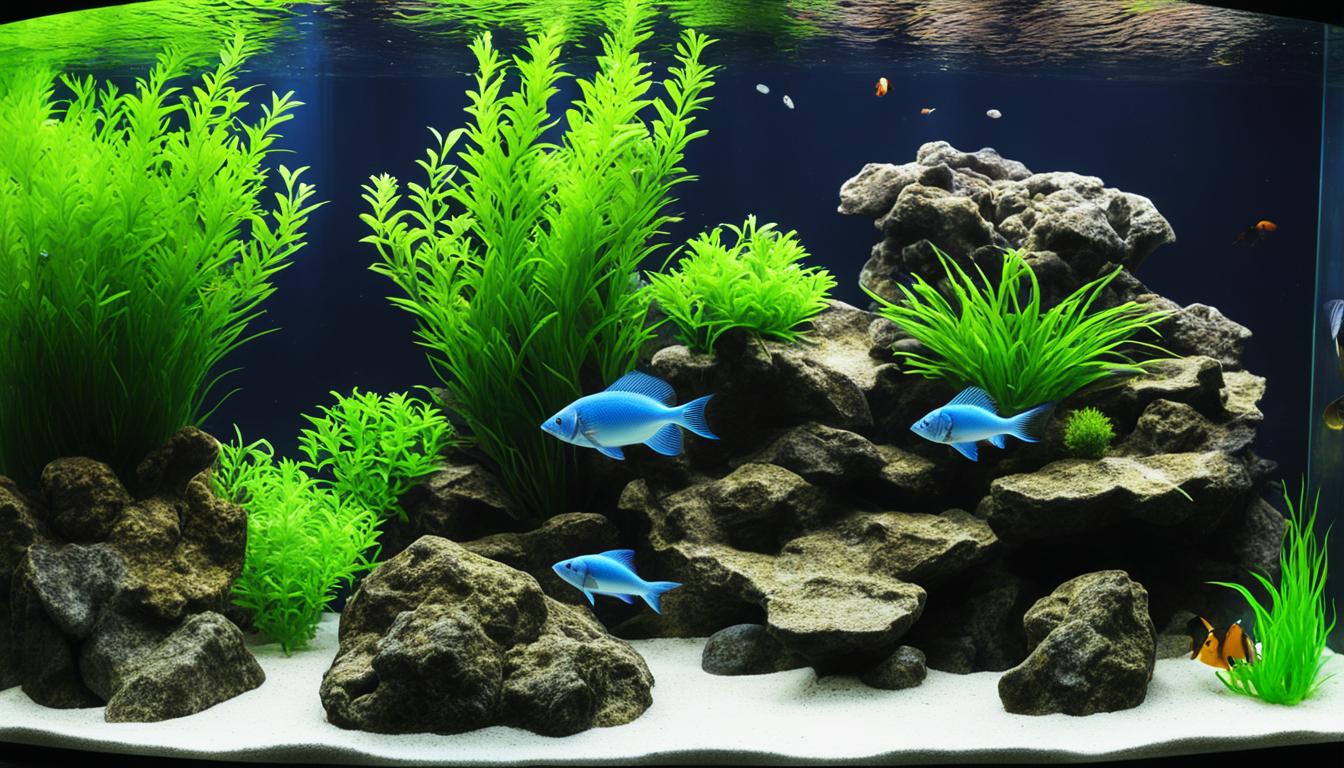Beginner Fishkeeping Mistakes: Welcome to the wonderful world of fishkeeping! As a beginner, you’re likely excited to start your journey and create a beautiful aquatic habitat for your fish. However, it’s essential to be aware of the common mistakes that beginners make in fishkeeping. These mistakes can be detrimental to your fish’s health and overall well-being, so it’s essential to avoid them.
In this article, I will discuss the most common mistakes that beginner fishkeepers make and provide you with the necessary information to avoid them. From inadequate tank cycling to poor filtration systems, I will cover all the most significant pitfalls and offer guidance on how to create a healthy and thriving environment for your fish.
Table of Contents
Key Takeaways:
- Conduct thorough research before starting a fishkeeping journey
- Avoid overstocking the tank
- Monitor and maintain proper water parameters
- Proper tank cycling is crucial for establishing a stable environment
- Invest in adequate filtration to maintain water quality
Lack of Research
Starting a fishkeeping journey can be exciting, but it’s important to conduct thorough research before diving in. As a beginner, there are many fishkeeping errors that can be easily avoided with proper research. Let me highlight some key aspects that beginners should consider.
Tank Size
One of the biggest avoidable mistakes in starting fishkeeping is selecting a tank that is too small. Do not be tempted to purchase a small tank just because it fits your budget or available area. Fish require adequate space for swimming, and cramming too many fish in a small tank can lead to poor water quality and fish stress. A general rule of thumb is to provide at least one gallon of water per inch of fish.
Water Conditions
Another important factor to consider is the water conditions. Different fish require different water parameters, such as pH, temperature, and hardness. It’s essential to research the requirements of the specific fish species you plan to keep and ensure the water conditions are suitable for them. Testing kits are available to help monitor and maintain appropriate water parameters.
Fish Compatibility
Choosing compatible fish species is crucial for the wellbeing of your fish. Some fish are aggressive and may not get along with others, while some species have specific feeding or environmental needs. Researching the compatibility and requirements of different species can help prevent conflicts and ensure a harmonious community tank.
Remember, a few hours of thorough research can save you from making costly beginner fishkeeping mistakes.
Overstocking the Tank
One of the most common beginner fish tank mistakes is overstocking the tank. It can be tempting to fill the aquarium with as many fish as possible, but this can have negative consequences for the well-being of the fish and the overall health of the tank.
When there are too many fish in a small space, the water quality can quickly deteriorate, leading to stress and disease for the fish. To prevent this from happening, it’s essential to research the proper stocking levels for the size of your tank and the needs of the fish species you’re interested in keeping.
Tip: A general rule of thumb is to have no more than one inch of fish per gallon of water in the tank. However, this can vary depending on the species of fish and their individual requirements.
“Overstocking fish tanks can lead to poor water quality, which can damage the health of the fish and even lead to death. It’s crucial to properly stock your aquarium to ensure a healthy and happy environment for your fish.”
Neglecting Water Parameters
As a beginner fishkeeper, neglecting water parameters is one of the top fishkeeping mistakes to avoid. It’s important to monitor and maintain proper levels of pH, temperature, ammonia, nitrite, and nitrate in your tank to ensure a healthy environment for your fish.
When pH levels are too high or low, it can cause stress on fish and affect their overall health. Ammonia, nitrite, and nitrate levels can also impact fish health and cause diseases if not properly controlled. It’s crucial to test the water regularly and make adjustments as needed.
One way to easily maintain water parameters is by investing in a quality water test kit. These kits can provide accurate readings within minutes and help you make informed decisions on necessary adjustments.
Remember, neglecting water parameters is an avoidable beginner fishkeeping pitfall. By taking the time to monitor and maintain proper levels, you can ensure a happy and healthy environment for your fish to thrive in.
Poor Tank Cycling

If you are new to fishkeeping, you might not be familiar with the concept of “tank cycling”. This process is crucial for establishing a stable and healthy environment for fish to thrive in your aquarium. Unfortunately, poor tank cycling is one of the common fishkeeping mistakes for newbies, which can lead to fish stress, illnesses, and even fatalities.
Proper tank cycling involves establishing the nitrogen cycle, which is the process of converting toxic waste produced by fish into less harmful substances. Here’s how to properly cycle your tank:
- Prepare your tank: Fill your tank with water and add a water conditioner to remove harmful chemicals such as chlorine and chloramine.
- Add beneficial bacteria: Bacteria will help break down fish waste into less harmful substances. Add some beneficial bacteria, which are available in liquid or powder form, to your tank.
- Add a source of ammonia: Ammonia is essential for the growth of beneficial bacteria. You can add fish food or pure ammonia to your tank to start the cycling process.
- Monitor water parameters: Test the water daily for ammonia, nitrite, and nitrate levels. During the cycling process, you will see a spike in ammonia levels, followed by a spike in nitrite levels, and eventually a drop in levels of both substances. This indicates that the nitrogen cycle is established in your tank.
- Do partial water changes: During the cycling process, it’s important to do partial water changes to keep the water clean and remove excess ammonia and nitrite. Do not change all the water at once, as this can disrupt the cycling process.
Remember, tank cycling is an ongoing process and should continue even after you have added fish to your tank. Avoid the common fishkeeping mistake of poor tank cycling to ensure a happy and healthy environment for your fish.
Inadequate Filtration
Having a proper filtration system is essential to maintaining a healthy and thriving fish tank. Inadequate filtration can lead to fish stress and diseases, poor water quality, and a buildup of harmful toxins. As a beginner, it might be challenging to choose the right type of filtration system, but fear not, I’m here to help!
There are three main types of filtration, including mechanical, biological, and chemical. Mechanical filtration removes debris, while biological filtration eliminates harmful toxins through the nitrogen cycle. Chemical filtration uses activated carbon to remove impurities from the water.
As a beginner, it’s recommended to start with a simple hang-on-back filter that combines mechanical and biological filtration. Make sure to choose a filter that is appropriate for the size of your tank and always follow the manufacturer’s instructions. Remember to clean or replace the filter media regularly to maintain optimal water quality.
Improper Feeding Practices

Feeding fish may seem simple, but it’s actually one of the most common beginner fishkeeping mistakes. Many new fish keepers make the mistake of choosing the wrong type of food, feeding their fish too often, or overfeeding, which can lead to poor water quality, fish stress, and even death.
When choosing fish food, it’s important to consider the specific dietary needs of your fish species. Some fish are omnivores, while others are herbivores or carnivores, so make sure to select a suitable diet for your fish. Additionally, feeding too often or too much can result in excess waste, which can overload the filtration system. It’s recommended to feed fish small amounts of food 1-2 times per day, depending on the species and size.
Pro Tip: Use a timer or schedule to remind yourself when to feed your fish and how much to give them to avoid overfeeding.
Overfeeding also makes it more difficult to maintain optimal water parameters, which can lead to fish stress and health problems. Uneaten food left in the tank can quickly decompose, releasing harmful toxins like ammonia and nitrite, which can be fatal to fish. Ensure you remove any uneaten food after a few minutes to keep the water clean and prevent health issues for your fish.
Types of Fish Food
| Type of Fish Food | Description |
|---|---|
| Flake Food | A common type of fish food available in many varieties, suitable for most fish species. |
| Frozen Food | Includes various types of food, such as brine shrimp, bloodworms, and krill, with high protein content, suitable for carnivorous fish. |
| Pellets | Sink slowly, making them suitable for bottom-dwelling fish. Available in different sizes, suitable for various fish species. |
| Veggie Flakes | Contain spirulina and other greens that herbivorous fish require and are a great additional food for omnivores. |
Proper feeding practices are crucial for your fish’s health and well-being. Invest time in learning about your fish species and their dietary requirements to avoid common beginner fishkeeping mistakes.
Lack of Tank Maintenance
As a beginner fishkeeper, it can be easy to forget about maintaining the tank, but it’s crucial for your fish’s health and well-being. Neglecting regular tank maintenance can lead to a buildup of harmful chemicals and bacteria in the water, which can cause stress and disease in your fish. To avoid these beginner fishkeeping mistakes, follow this essential maintenance checklist:
| Maintenance Task | Frequency |
|---|---|
| Water changes | Weekly |
| Cleaning the filter | Monthly |
| Scrubbing algae off tank walls and decor | As needed |
| Testing water parameters | Weekly |
| Replacing expired filter media | Every 3-6 months |
By performing these tasks regularly, you can ensure a healthy and stable environment for your fish. Don’t forget to also keep an eye on any equipment, such as lights and heaters, to make sure they are functioning properly.
Remember, neglecting tank maintenance is one of the top fishkeeping blunders to avoid. Stay on top of your tank maintenance and your fish will thank you for it!
Conclusion
As a seasoned fishkeeper, I understand the challenges that come with starting out as a beginner in this hobby. However, by avoiding these common fishkeeping mistakes, you’ll set yourself up for success and enjoy a thriving aquatic environment. Remember to conduct thorough research, properly cycle your tank, maintain proper water parameters, and avoid overstocking. Also, ensure that your tank has adequate filtration, practice proper feeding habits, and regularly maintain your tank. By doing so, you’ll have a healthy and happy aquatic community.
Don’t be discouraged if you make mistakes along the way. Every pet owner has, but with practice and knowledge, you’ll become a pro in no time. Remember, the key is to learn from your mistakes and keep moving forward.
Thank you for taking the time to read this article on the most common beginner fishkeeping mistakes. I hope you found it informative and useful for your fishkeeping journey. Happy fishkeeping!
FAQ
What are some common beginner fishkeeping mistakes?
Some common beginner fishkeeping mistakes include lack of research, overstocking the tank, neglecting water parameters, poor tank cycling, inadequate filtration, improper feeding practices, and lack of tank maintenance.
How can I avoid these fishkeeping mistakes?
To avoid these mistakes, it is important to conduct thorough research before starting your fishkeeping journey. Spend time learning about tank size requirements, water conditions, and fish compatibility. Avoid overstocking the tank by following proper stocking levels and preventing overcrowding. Regularly monitor and maintain proper water parameters such as pH, temperature, ammonia, nitrite, and nitrate levels. Follow the correct tank cycling process to establish a stable and healthy environment. Choose and maintain an adequate filtration system for your tank. Feed your fish the right type of food in appropriate quantities and frequency, while avoiding overfeeding. Lastly, establish a regular tank maintenance routine that includes water changes, cleaning, and equipment upkeep.
What are the consequences of overstocking a fish tank?
Overstocking a fish tank can lead to poor water quality, increased waste production, and stress among the fish. It puts strain on the filtration system and can lead to higher ammonia and nitrate levels, which are harmful to fish health. Overstocking also limits swimming space and overcrowding can cause aggression and territorial disputes among fish.
How important is proper tank cycling?
Proper tank cycling is crucial for establishing a stable and healthy environment for fish. It allows beneficial bacteria to colonize the tank, breaking down toxic ammonia into nitrite and then into less harmful nitrate. Without proper cycling, ammonia levels can spike and harm the fish, leading to stress, diseases, and potential fatalities.
What type of filtration system should beginners choose for their fish tank?
Beginners should choose a filtration system that suits their tank size and type. The three main types of filtration systems are mechanical, chemical, and biological filtration. Most filters combine all three, offering efficient water cleaning and toxin removal. It is important to choose a filter that has adequate flow rate and is capable of handling the tank’s volume.
How often should I feed my fish and how much?
The frequency and quantity of fish feedings depend on the type of fish you have. Generally, it is recommended to feed small amounts two to three times a day, ensuring they consume the food within a few minutes. Avoid overfeeding, as uneaten food can lead to poor water quality and potential health issues for the fish.
What is the importance of regular tank maintenance?
Regular tank maintenance is essential for maintaining good water quality and a healthy environment for your fish. It includes tasks such as regular water changes, cleaning of tank decorations, gravel vacuuming, filter media replacement, and equipment upkeep. Neglecting tank maintenance can lead to poor water conditions, increased nutrient levels, and higher risks of fish diseases and health issues.
References
- International Federation of Online Clubs and Aquatic Societies (IFOCAS)
- Federation of British Aquatic Societies (FBAS)
- Northeast Council of Aquarium Societies (NEC)
- Federation of American Aquarium Societies (FAAS)
- Marine Aquarium Council (MAC)
Please also check other articles on this website like:
Master Breeding Techniques for Angelfish – A Guide for Hobbyists
Mastering Dwarf Puffer Fish Care: A Friendly Guide
Male or Female Betta? How to Tell – Your Ultimate Guide
Complete Guide to Plecostomus Tank Size: Tips and Advice
Simple Guide to Easy-to-Care-for Aquarium Plants
Discover the Diverse Corydoras Catfish Varieties- A Guide
Get to Know Various Types of Algae Eaters
Master Guide: Best Water Parameters for Goldfish Care 2023-24
Mastering Black Ghost Knife Fish Care: A Comprehensive Guide
Optimal pH Levels for Tropical Fish: Essential Aquarium Guide
Discovering Freshwater Snail Species: An In-depth Guide
Expert Tips for Breeding Guppies: Keys to Successful Fishkeeping
Discover Peaceful Community Fish: Your Guide to Calm Aquatics
Ultimate Guide to Live Food for Betta Fish — Healthy Choices
Complete Guide to Your Perfect Cichlid Tank Setup
Your Guide to the Best Substrate for Planted Aquariums
Essential Guide to Discus Fish Care: Help Your Pets Thrive!
Grow Your Own Eden: Beginner-Friendly Aquascaping Plants Guide
Perfect Neon Tetra Tank Mates: Guide to Aquarium Harmony
Product Review of Eheim Classic vs Professional
The Ultimate Guide to Discus Fish Care
What Fish Can Live With Discus?
Ideal pH for Discus Fish | Aquarium Water Guide
How to Sex Discus Fish?: A Simple Guide for Hobbyists
Complete Discus Fish Tank Setup Guide
Can Discus Fish Live With Angelfish? The Complete Guide
Discus Diet Guide: What Do Discus Fish Eat?
Are Discus Fish Hard to Keep? Insights & Tips.
Optimal Discus Fish Water Parameters Guide
Discus Fish Size Guide 2024: How Big Do Discus Fish Get?
Ultimate Million Fish Guppy Care Guide 2024
Simple Guide to Easy-to-Care-for Aquarium Plants
Grow Your Own Eden: Beginner-Friendly Aquascaping Plants Guide
Hornwort Aquarium Plants: The Ultimate Guide to Care and Maintenance
Aquarium Equipment for Beginners: The Complete Checklist
Feeding Your Aquarium Fish: The Complete Guide
I am a passionate aquarist with over 30 years of hands-on experience in fishkeeping. My journey began at a young age, collecting fish from the wild and learning through experimentation. Specializing in tropical fish, I bring a deep understanding of the hobby to FishKeepingMadeSimple. The site provides honest, detailed reviews of essential products and accessories to help fellow enthusiasts create the best environments for their fish.










[…] Common Beginner Fishkeeping Mistakes and How to Avoid Them! […]
[…] Common Beginner Fishkeeping Mistakes and How to Avoid Them! […]
[…] Common Beginner Fishkeeping Mistakes and How to Avoid Them! […]
[…] Common Beginner Fishkeeping Mistakes and How to Avoid Them! […]
[…] Common Beginner Fishkeeping Mistakes and How to Avoid Them! […]
[…] Common Beginner Fishkeeping Mistakes and How to Avoid Them! […]
[…] The White Tetra Fish, also known as the White Skirt Tetra, is a visually striking and peaceful addition to a freshwater aquarium community. They can live up to seven years and are easy to breed, making them a great choice for beginner fishkeepers. […]
[…] be as extensive as with specialized breeders, local pet stores can be a great starting point for beginners or those looking for more common koi […]